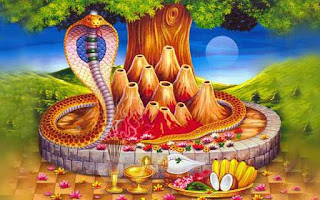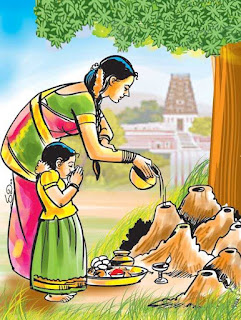Indian Festivals
Nag Panchami Date 2023 : Importance, Celebrations and History
Nag Panchami is an Indian festival to be celebrated all over India in the month of August as per the English Calendar. It falls on the Shukla paksha Panchami of “Sravan masa” every year and this year it is to be celebrated on Monday, August 21, 2023
Panchami Tithi Begins – 12:21 AM on Aug 21, 2023
Panchami Tithi Ends – 02:00 AM on Aug 22, 2023
Importance of Nag Panchami
In India, snakes are the highly auspicious creature who resides in the neck of Lord Shiva whereas it provides a comfortable seat to Lord Vishnu. For many decades, snakes are worshiped on every occasion and offering prayers along with fruits and milk bless an individual with boons and happiness.
It is believed that snakes reside in “patal lok” which is also known as “nag lok” and on this day plowing a field is strictly prohibited which may harm a snake in some or other ways. Be it North India or South India people celebrate this festival in their own ways. Since snakes are closer to our almighty god one never kills a snake intentionally due to fear of getting bad curses.

In astrology also snakes influence our life by giving us positivity in our life and sometimes it also inhibits one’s growth by influencing us with “Kala Sarpa Dosha”. Kala Sarpa dosha occurs due to ill effects of killing a snake by us or by our ancestors which keeps haunting an individual in their dreams. This dosha hinders the prosperity and in all prospects of life unless and until we offer our prayers to snakes god. King cobra and many other snakes are there whom prayers are offered either in the form of their images, metallic idols or in real.
Nag Panchami Vrat
Nag Panchami is one of the most famous festivals in Hindus. This Vrat completely dedicated to all Snake gods as Nag Devtas and is a passionately observed celebration in different ways in the country. Basically, Nag Panchami falls in the Shravan month (July – August) and is determined during Panchami tithi (fifth day) of Shukla Paksha (bright half of lunar month). This day is called as Nagamanandakari indicates the meaning as the happiest day for Nag Devtas (serpent gods) in the Hindu religion.
Generally, this ritual comes two days after Hariyali Teej. Although it has a number of variations in Vrat and all women get the blessing from ‘Nag Devta’ and offering milk to the ‘Nagam’(snake) during this day. The main focus to worship on this day is for the well-being of the brothers of the women. In general, this puja is said to bestow prosperity and protection to the family.

Nag Chaturthi is another name of Nag Vrat in south India. This day comes after the fourth day of Shukla Paksha ( full moon day) which falls on before the day of the Panchami. Some of those who customarily attend Nag Panchami fasting on Nag Chaturthi also conclude the puja the next day. This Vrat is determined with a deep description of the puja of NagDevtas. This Naga Chaturthi comes after Diwali celebrations. Gujarat people performed the fifth day of Krishna paksha Panchami (fifth day of the dark half of lunar month) on Shravan month.
Fasting on Nag Panchami
During the Nag Panchami, many people do fast on the day to satisfy the Snake or Naga Devtha god. A new young married couple performed the fasting for the well-being of husband and unmarried female is going to fast to find a good better being to life. The fast begins with the early morning before the sunrise and continues until sunset. After that ‘kheer’ is offered to the Snake God and the fast complete with dessert. Salt and fried food are not optional for this ritual, some people start with fasting from before one day of Nag Panchami.
Celebrations of Nag Panchami
The festival of Nag Panchami is celebrated all over India, Nepal and other Hindu resident countries. Observing fasts, offering milk, rice pudding and flowers to snakes in temples is assumed to be very auspicious and protects us from snake bites. In some part of India, it is also known as “Bhratru Panchami” where women offer prayers to the snake god along with their brothers. It is celebrated to protect brothers from any kind of snake bites and other related things.
In south India placing a lotus flower in a silver plate and applying sandalwood paste, kumkum and drawing rangoli all around the plate is very famous. Prayers are offered to the plate and people wish to make their dreams come true.
Like all others, this festival is also celebrated all over India with different names and patterns where Punjab celebrates it in the name of “Guga Nauvami”, western India as “Kshetrapal” which means the protector and “Manasa” in eastern states of India.
History of Nag Panchami
Nag Panchami festival has its roots in our ancient history which dates back to the period of Mahabharata. It is said that King Parikshit was being bitten by the king of snakes “Takshak” which lead to the death of king parikshit. This event shocked the son of parikshit “Janamejaya” and out of rage he organized a huge yagya or fire which was known as “Sarpa Satra yagna”. This yagya was organized to force all the snakes on the earth to jump into that fire. Snake king Takshak who went to Lord Indra for asking help was holding the bed of Indra but due to the immense power of the verses and mantras along with the fire dragged him to fire with Lord Indra himself.

This situation shook the whole Earth as Lord Indra was the king of all devtas and then Lord Brahma took the help of Goddess Manasa Devi. Maa Manasa Devi sent her daughter “Astika” to Janamejaya to stop the fire and astika succeeded in her work. That day was the fifth day of Shravan masa and from that day itself it is celebrated an as “Nag Panchami”.
This festival resembles the protection of snakes from any kind of danger and lets them live peacefully with humans forever.

